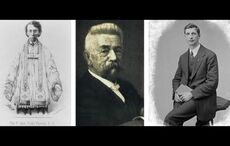Following in the footsteps of Heaney, J.M. Synge, W.B. Yeats, Thackeray & Holt, at the Count Wicklow beauty spot and further afield.
"No man can walk in such a place without feeling grateful, and grave, and humble, and without thanking heaven for it as he comes away.”
So wrote the English Author William Makepiece Thackeray on the delights of the Devil’s Glen following a tour around some of the scenic highlights of County Wicklow in 1842.
The Glen owes its fearsome title to the supposed thunderous, satanic roar which emanated from the waterfall at the head of the Glen “where the river Vartry falls about one hundred feet with astonishing fury into the Glen”. This spectacle is now somewhat diminished following the construction of the Vartry reservoir upstream at Roundwood, in 1860, which resulted in a much-restricted flow and consequently a less dramatic spectacle.
Nonetheless, it remains a glorious sight to behold and is a fine reward for the intrepid visitor who has ventured into the deep craggy gorge of the glen or traversed the spectacular high cliff walk.
By the mid-19th century the Devil’s Glen had been accessible for visitors for some fifty years and was firmly established along with; Glendalough, Glen of the Downs, Luggala, Powerscourt, and Pollaphuca as a must-see location on every Gentleman’s itinerary of County Wicklow. The Glen was carved out by glacial ice - melt leaving a deep rocky ravine embosomed by high cliffs looming over the Vartry River dramatically flowing through the boulder-strewn valley en route to the sea.

This type of spectacular feature was greatly prized by the landed Gentry who were busy consolidating their estates in County Wicklow. In this case, it was the demesne of Francis Synge, Great grandfather of the radical playwright and poet John Millington Synge. Francis Synge had acquired the core of the estate in 1796 along with a large house which was picturesquely set overlooking the Glen with sea views to the south-east.
At great expense, Synge embarked on a massive vanity project which would involve transforming the house and the Glen into a fitting location for a man of his perceived social standing. He commissioned Ireland’s foremost architect, Francis Johnston to redesign the house and by adding Turrets, bartizans, and castellations, Gothicized the building.
The resultant metamorphosis was Glanmore Castle, Castle of the Great Glen. The Castle was visible from the Glen below fulfilling his dream in it becoming the crowning glory of the Glen. Francis Synge planted hundreds of trees at different heights in the glen to produce beautiful combinations of foliage in spring and autumn and scattered cherry trees throughout the forest resulting in stunning displays of white spring blossoms. Viewing platforms were established on rocky outcrops giving fabulous vistas over the treetops or to the sea, and footpaths were created enabling circuitous walks. Following his death in 1831, Francis Synge’s son John would carry on his Fathers work, adding more paths including “a great flight of five hundred rustic steps, winding up like a goat track among the trees on the steep side of the glen”.
J.M. Synge adored spending time in Wicklow and especially in the Devil’s Glen of which he possessed, an intimate knowledge of its hidden wonders. He had spent a considerable part of his childhood holidaying in the vicinity of the glen and would take great delight in escorting friends and visitors from his Aunt’s house nearby at Tiglin farm in the upper glen, down to the waterfall or take the cliff walk winding its way along the precipitous upper glen threading its way through the magnificent arch, which his Grandfather, utilizing the labor of welsh slate miners, had laboriously hand cut through solid rock.
Although a Dubliner by birth JM Synge considered himself a Wicklow man and would gain invaluable inspiration from its landscape and people. This would become very apparent in his writing and in his religious and political views which would cause some consternation amongst his family contrasting their deep-seated ultra- conservative ascendency attitudes. After a chance meeting with W.B. Yeats in Paris, he would at Yeats suggestion, further develop his naturalistic style by immersing himself in Irish Gaelic culture with visits to the West of Ireland and the Arran islands which would be the setting for his masterpiece The Playboy of the Western world. Synge would become firm friends with W.B. Yeats and his brother, the painter Jack B. Yeats. His relationship with Jack would result in an epic journey around Mayo and Galway which would prove to be in the author's words as ’Out-of-the way corners in Mayo and Galway that were more strange and marvelous than anything I’ve dreamed of.’ These gems of social observation accompanied by Yeats’ evocative drawings were commissioned and published by the Manchester Guardian to highlight the extreme poverty of the people living in “the congested districts.” The articles and drawings would eventually be crystallized in the form of a book Travels in Wicklow, West Kerry, and Connemara, posthumously published with other articles in 1911 three years after the untimely death of the Author in 1909.
“Still South I went and West and south again through Wicklow from the morning till the night and far from the cities and the sights of man lived with the sunshine and the moons delight” Prelude by John Millington Synge.
The Poet and Nobel Laureate Seamus Heaney lived with his wife Marie in one of the former gate lodges on the Glanmore estate and immortalized the area in poetic verse in Glanmore sonnets. Heaney also left a more tangible legacy in the form of the ‘Seamus Heaney walk’. The trail which climbs dramatically through the high forest is punctuated by much welcome wooden benches, delightfully inscribed with stanzas from the poet’s poems. The trail eventually loops back down twisting and turning through groves of oak, alder and Scots pine offering tantalizing glimpses of verdant mossy glades and a panoramic sea view stretching behind the former home of the Great man – A fitting memorial to a man so in tune with nature and so evocative of the author of Death of a naturalist. ‘Walk on air against your better judgment’ (epitaph) Seamus Heaney.
Massacre in the Glen
Joseph Holt was a prosperous substantial, protestant farmer and wool dealer who forced by circumstance and conscience became an inspirational revolutionary leader rising to the rank of General of the United Irishmen in the rebellion of 1798. Holt was described as “industrious, peaceable, loyal and well to do in the World had a humane and honest heart and no liking for Orangism” This distaste for Orangism probably led to his gravitation to the Nationalist cause as he was denounced as a Catholic sympathizer by an ‘Orange Squireen’ who bore a grudge and owed him a considerable sum of money. Consequently, Holts house was burnt to the ground. Holt then revealed himself as a rebel and rushed “like a fury to a place called the Devil’s Glen and there passed the night in a cave where there were collected a few unfortunate persecuted creatures like myself”
The 1798 rebellion was bloody and cruel and bands of local Yeomanry; The Wicklow town Yeomanry and enlisted regiments like the Dunbartonshire fencible infantry were instrumental in enforcing state-backed terrorism. Following the rout of a large rebel force at Newtownmountkennedy the crown forces led by Major Joseph Hardy were ordered to give no quarter. The rebel forces seeking sanctuary in the oak woods of Ballycory on the northern side of the Devil’s Glen were burnt out and then brutally massacred. This along with torture, random floggings, house burning, and summary executions were methods explicitly sanctioned by the Crown.
Happily, the Devil’s Glen is now an oasis of peace and tranquility; in springtime, the scent of wild garlic fills the air and the forest is alive with birdsong: Black birds, Blackcaps, Thrushes, Wrens in competition with wood pigeon, willow warblers and chiffchaffs. Hawks dominate the upper glen and Buzzards can be observed circling menacingly high above. Unfortunately, the State Forestry body Coilte has allowed unchecked conifer growth to completely obscure the view of Glamore castle from the glen, masking one of the most romantic views in Ireland!
This article was submitted to the IrishCentral contributors network by a member of the global Irish community. To become an IrishCentral contributor click here.




Comments